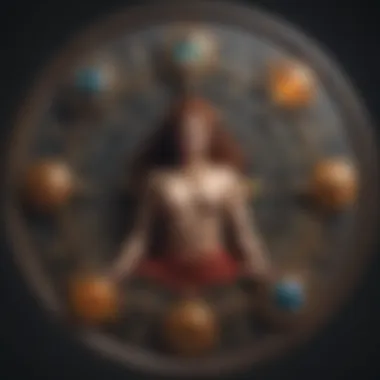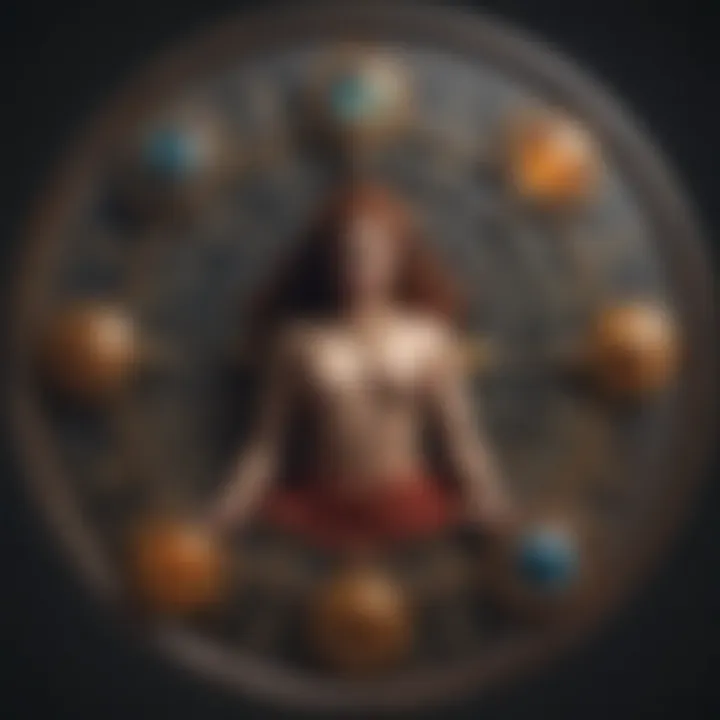Decoding the Circle Birth Chart: Unveiling Astrological Insights


Intro
Understanding astrology requires a foundation in its basic elements, one of which is the circle birth chart. This chart acts as a personal cosmic fingerprint, providing insights into an individual's personality, behavior, and life path. By decoding the arrangement of celestial bodies at the time of birth, one can unveil the influences that shape various aspects of life. Astrology is not just about predicting the future; it is a tool for self-awareness and growth. The exploration of this chart involves a detailed examination of zodiac signs, houses, and the relationships between these elements.
Understanding the Zodiac
Overview of Zodiac Signs
The zodiac is composed of twelve distinct signs, each representing unique characteristics and energies. These signs are divided into four elements: Fire, Earth, Air, and Water. The qualities associated with these elements lay the groundwork for understanding personality traits and behaviors.
- Aries: Energetic, pioneering, and sometimes impulsive.
- Taurus: Grounded, practical, with an appreciation for beauty and comfort.
- Gemini: Adaptable, curious, and often sociable.
- Cancer: Intuitive, emotional, and nurturing.
- Leo: Charismatic, confident, and a natural leader.
- Virgo: Detail-oriented, analytical, and service-minded.
- Libra: Diplomatic, relationship-focused, with a love for harmony.
- Scorpio: Intense, transformative, and driven by passion.
- Sagittarius: Adventurous, philosophical, and freedom-loving.
- Capricorn: Disciplined, ambitious, and goal-oriented.
- Aquarius: Innovative, humanitarian, often ahead of their time.
- Pisces: Compassionate, imaginative, with a connection to the spiritual.
Sign Traits and Characteristics
Each zodiac sign carries specific traits that influence an individual’s personality. For example, a Gemini is typically known for their adaptability and communication skills, while a Capricorn might demonstrate a strong work ethic and ambition. Knowing your sun sign helps in interpreting one's basic personality structure.
Elemental Qualities
The four elements categorize the zodiac signs further:
- Fire (Aries, Leo, Sagittarius): Symbolizes passion, enthusiasm, and action.
- Earth (Taurus, Virgo, Capricorn): Represents stability, practicality, and material concerns.
- Air (Gemini, Libra, Aquarius): Aligns with intellect, communication, and social connections.
- Water (Cancer, Scorpio, Pisces): Resonates with emotions, intuition, and empathy.
Astrological Insights
Current Astrological Trends
Astrological trends provide context to how celestial shifts affect daily life. As planets transition through signs and houses, they activate certain energies that can amplify or dampen specific traits. For those interested in astrological practices, keeping track of these movements is essential.
Influence of Celestial Events
Celestial events like eclipses, retrogrades, and planetary alignments serve as catalysts for change and self-reflection. Each event can affect personal and collective experiences in varied ways, thus holding significant meaning in one's birth chart interpretation.
How to Interpret Your Birth Chart
Interpreting a birth chart involves analyzing the positions of the sun, moon, planets, and their relation to each other. To start:
- Locate your sun sign in the zodiac wheel, which represents your core personality.
- Identify your moon sign for emotional undercurrents.
- Consider the rising sign (ascendant) as a representation of how you present to the world.
Horoscope and Predictions
Monthly or Weekly Forecasts
Personalized forecasts can provide guidance on upcoming challenges and opportunities. These predictions often cover various life areas, offering insights about relationships, career, health, and more.
Personalized Horoscope Reading
Engaging in personalized horoscope readings can enhance one's understanding of astrological influences in daily life. These interpretations can clarify the impact of current celestial alignments on personalities and decisions.
Compatibility Readings based on Zodiac signs
Compatibility readings evaluate relationships through zodiac comparisons. Understanding how different signs interact helps deepen relationships and navigate challenges. The complexities of each sign can reveal strengths and potential conflicts, providing a framework for healthier connections.


Intro to the Circle Birth Chart
The circle birth chart is a key element in the study of astrology. Understanding this chart aids in gaining insights into an individual's personality, challenges, and potential life paths. This article emphasizes the relevance of the circle birth chart, which serves as a map of celestial influences at the time of one’s birth. By grasping its significance, readers can better understand how these elements shape their existence.
Defining the Circle Birth Chart
A circle birth chart, also known as a natal chart, represents the positions of celestial bodies at the moment of one's birth. It is usually depicted as a circular diagram divided into twelve sections or houses. Each section signifies an area of life, such as relationships, career, and self-identity. The chart showcases the zodiac signs in which the Sun, Moon, and planets reside, illustrating their unique energies and influences. Astrologers analyze these patterns to interpret various personal attributes and behaviors. The circle birth chart thus serves as a personalized astrological blueprint, reflecting both potential and challenges.
Historical Context and Evolution
Astrology has deep roots extending back thousands of years. The concept of the birth chart emerged in ancient civilizations such as Babylon, where celestial observations informed belief systems. Over time, aspects of astrology evolved, shaped by different cultures including Greek and Indian traditions. The transition from a geocentric view to a more complex understanding of planetary movements marked a significant evolution in astrological practices. Various historical texts and studies illustrate how the circle birth chart has adapted while maintaining its core function of guiding and informing individuals about their life paths. Today, it continues to be a vital tool for astrologers, providing a reference point to unlock personal insights and develop meaningful interpretations.
Components of the Circle Birth Chart
Understanding the circle birth chart involves recognizing its components. Each element serves a specific function. Together, they provide a comprehensive overview of an individual's astrological profile.
The significance of these components lies in their ability to reveal patterns. They help in understanding one’s personality traits, relationships, and life direction. Everyone is influenced by the positions of celestial bodies at the time of their birth. This insight can lead to self-awareness and personal growth.
The Zodiac Wheel Explained
The zodiac wheel is a fundamental aspect of the birth chart. It consists of twelve segments, each representing a different zodiac sign. These signs are Aries, Taurus, Gemini, Cancer, Leo, Virgo, Libra, Scorpio, Sagittarius, Capricorn, Aquarius, and Pisces.
Each sign corresponds to distinct traits. For example, Aries is known for its assertiveness while Pisces embodies sensitivity. The arrangement of these signs in the zodiac wheel is crucial for interpretation. It determines the house placement of planets. The signs influence how the planets express themselves in an individual’s life.
Moreover, the wheel is divided into two hemispheres—northern and southern. The significance of this division relates to external and internal focuses in one’s life. It affects how individuals navigate their environments and personal journeys.
Planets and Their Influences
Planets play a vital role in astrology. Each planet governs different aspects of life and carries unique energies. For instance, the Sun represents the core self and vitality. The Moon affects emotions and instincts.
Other planets include Mercury, Venus, Mars, Jupiter, Saturn, Uranus, Neptune, and Pluto. Their positions in the birth chart provide insights into personal challenges, strengths, and behavioral tendencies.
- Inner Planets: Mercury, Venus, and Mars. These influence day-to-day experiences and personal interactions.
- Outer Planets: Jupiter, Saturn, Uranus, Neptune, and Pluto. They shape generational influences and long-term life cycles.
The aspects these planets create with one another also shape the individual’s experience. Understanding these dynamics is central to astrological interpretation.
Astrological Houses Overview
Astrological houses are divisions in the birth chart. There are twelve houses, each representing specific areas of life. These include self-identity, finances, communication, home, and relationships.
The first house begins with the Ascendant, often called the Rising Sign. It sets the tone for how individuals present themselves to the world. Each house influences different life experiences. For example:
- 1st House: Self-identity and appearance.
- 2nd House: Finances and possessions.
- 7th House: Partnerships and marriage.
The placement of planets within these houses informs how individuals navigate their experiences. This structure offers a roadmap to understanding various life themes.
Aspects and Their Significance
Aspects refer to the angles formed between planets in the birth chart. These angles reveal interactions between different planetary energies. Key aspects include conjunctions, oppositions, trines, squares, and sextiles.
Understanding these aspects enhances chart analysis. For instance, a conjunction may indicate a blending of energies, while a square may signify tension. Each aspect provides a unique lens through which to view relationships between influences in an individual’s life.
The interplay of aspects can highlight opportunities for growth or suggest challenges to overcome. Recognizing these patterns is essential for astrological interpretation.


In summary, the components of the circle birth chart form a complex framework. They interact to create a unique astrological profile that offers insights into various life experiences.
Understanding Zodiac Signs in the Birth Chart
Zodiac signs play a crucial role in a person's circle birth chart. Each sign symbolizes distinct personality traits and influences behaviors. Understanding these signs is essential. They serve as the bedrock of astrological interpretation, guiding individuals in self-discovery and personal growth. The analysis of zodiac signs also reveals how one interacts with the world. This understanding can lead to more fulfilling relationships and better decision-making.
Furthermore, zodiac signs help contextualize other factors present in a birth chart. They interact with planets, houses, and aspects, creating a rich tapestry of insights. By recognizing these connections, one can appreciate the complexity of individual experiences and choices in life. The exploration of these signs is not merely theoretical but offers practical applications. It enhances our awareness of strengths, weaknesses, and the opportunities for growth.
Personality Traits Associated with Each Sign
Each zodiac sign is associated with specific personality traits that influence individuals' behaviors and preferences. Below is a brief overview of the twelve signs and their corresponding traits:
- Aries: Energetic, assertive, and spontaneous.
- Taurus: Reliable, practical, and patient.
- Gemini: Adaptable, curious, and communicative.
- Cancer: Intuitive, emotional, and nurturing.
- Leo: Charismatic, confident, and creative.
- Virgo: Analytical, detail-oriented, and modest.
- Libra: Diplomatic, social, and fair-minded.
- Scorpio: Intense, passionate, and resourceful.
- Sagittarius: Adventurous, philosophical, and optimistic.
- Capricorn: Disciplined, ambitious, and responsible.
- Aquarius: Innovative, independent, and humanitarian.
- Pisces: Compassionate, artistic, and empathetic.
Understanding these traits can provide deep insights into one's character. It also reveals how individuals might respond in various situations. This information is useful not only for personal growth but also for enhancing interpersonal relationships.
Elemental and Modal Considerations
Zodiac signs are grouped into four elements and three modalities, which further enhance their interpretations.
Elements
- Fire Signs (Aries, Leo, Sagittarius): Represent enthusiasm and action. Individuals in these signs are often dynamic and passionate.
- Earth Signs (Taurus, Virgo, Capricorn): Epitomize stability and practicality. They tend to be grounded and reliable.
- Air Signs (Gemini, Libra, Aquarius): Symbolize intellect and communication. Those under these signs are typically social and analytical.
- Water Signs (Cancer, Scorpio, Pisces): Reflect emotion and intuition. They are often sensitive and nurturing.
Modalities
- Cardinal Signs (Aries, Cancer, Libra, Capricorn): Initiators who drive action and new projects.
- Fixed Signs (Taurus, Leo, Scorpio, Aquarius): Stable and determined; they often resist change.
- Mutable Signs (Gemini, Virgo, Sagittarius, Pisces): Adaptable and flexible; they thrive in changing environments.
These elemental and modal considerations add depth to the analysis of zodiac signs in birth charts. They help to paint a more detailed picture of an individual's personality and life approach, offering essential insights into personal tendencies and potentials.
Analyzing the Birth Chart
Analyzing the birth chart is a crucial step in astrology. It allows individuals to understand the complexities of their personality and life's journey. The birth chart serves as a snapshot of celestial positions at the moment of one's birth. It reveals insights into strengths, weaknesses, and natural inclinations. Therefore, examining this chart can be empowering and illuminating.
Methodologies for Interpretation
Astrologers employ various methodologies to interpret a birth chart. These methods can differ based on tradition and personal approach. Here are a few common techniques:
- Whole Sign Houses: This method divides the zodiac into twelve equal sections, assigning one sign to each house. It simplifies interpretation by providing clear boundaries for planetary influences.
- Placidus System: This technique calculates houses based on time and space, considering the exact degrees of celestial bodies. This allows for nuanced understanding but can become complex.
- Sidereal vs. Tropical Zodiac: Understanding the difference here matters. The sidereal zodiac aligns with constellations, while the tropical system is based on seasons.
- Aspect Analysis: This involves examining the angles between planets. Each aspect holds significance, indicating harmony or tension within one's psyche.
These methodologies contribute to a coherent interpretation of the birth chart. By utilizing these techniques, a reader can begin to articulate the relationships between signs, planets, and houses, building a full picture of astrological influences.
Identifying Key Positions
Identifying key positions within the birth chart is essential for accurate interpretation. These positions include:
- Sun Sign: Represents the core self and identity. It suggests vitality and logical thinking.
- Moon Sign: Reveals emotional depth. It gives insight into inner sensitivity and instinctual responses.
- Rising Sign (Ascendant): Reflects how others perceive you. It sets the stage for how you approach life.
- Midheaven: Indicates career aspirations and public persona. It outlines one's ambition and direction in life.
Astrologers look closely at planetary placements within houses and signs. Each planet carries its unique symbolism and significance, influencing how personal and external experiences unfold. Recognizing which houses are emphasized helps point to the areas of life where challenges and opportunities may arise.
In summary, the methodologies and identification of key positions provide a framework for understanding the intricate messages conveyed within the birth chart. This detailed analysis not only enhances self-awareness but also guides decision-making and personal growth.


Practical Applications of the Birth Chart
The circle birth chart serves not only as a measure of celestial positions but also as a lens through which individuals can gain insights into their lives. Understanding the practical applications of the birth chart is crucial for those engaged in astrology, including astrologers and seekers of self-knowledge. This section will explore how the birth chart can be utilized for self-discovery and personal development, as well as relationship compatibility analysis.
Self-Discovery and Personal Growth
The circle birth chart is a powerful tool for self-reflection. It reveals our intrinsic qualities, challenges, and potential paths. Here are some key aspects:
- Awareness of Strengths and Weaknesses: The chart highlights specific traits associated with each zodiac sign and house placement. Individuals can identify their natural abilities and areas where they might face difficulties.
- Navigating Life Choices: The birth chart can inform important life decisions, such as career choices or creative pursuits. By understanding one's astrological influences, individuals may align their choices with their true nature.
- Personal Growth Strategies: When one understands the aspects highlighting personal challenges, it becomes possible to develop targeted growth strategies. For example, someone with a challenging Mars placement may need to work on assertiveness and conflict resolution skills.
- Emotional Understanding: The chart sheds light on emotional patterns, allowing individuals to more effectively process their feelings and reactions. This understanding can lead to improved emotional intelligence.
Common Misconceptions About the Birth Chart
Understanding the circle birth chart often includes navigating through misconceptions that cloud this fascinating field. These misunderstandings can undermine the value of astrological insights and hinder the quest for self-awareness and personal growth. It's crucial to address these issues to deepen appreciation for the birth chart's complexity and utility.
Astrology vs.
Fortune Telling
A common myth is that astrology is synonymous with fortune-telling. While both disciplines involve predicting future events, astrology takes a more nuanced approach. It emphasizes patterns and influences over predetermined outcomes. The birth chart is a map of one's potential rather than a set path.
Many people think a reading will simply indicate what will happen in the future, but this misunderstands the role of personal agency. Astrological insights can guide decisions and illuminate life patterns, but they do not dictate outcomes. Understanding this distinction enhances the appreciation for astrology as a tool for empowerment.
- Astrology examines influences: It considers how celestial positions affect individual experiences.
- Fortune-telling often focuses on predictions: It tends to showcase immediate outcomes, sometimes omitting context.
- Empowerment through understanding: Recognizing your own agency is key in astrology; it encourages introspection and informed choices.
Understanding Free Will and Fate
Another significant misconception involves the balance between free will and fate in astrology. Some believe that one's birth chart is a strict blueprint of destiny, leaving no room for individual choice. This notion simplifies a more complex interaction. The birth chart outlines possibilities, tendencies, and challenges, but it does not impose rigid limitations.
Free will plays an essential role alongside the planets' influences. The choices individuals make can significantly alter how astrological energies manifest in their lives. A person with challenging aspects can still thrive by making conscious choices.
- Potential vs. Certainty: While the birth chart reveals potential, it lacks certainties.
- Interactivity of influences: Life experiences and choices interact constantly with astrological energies.
- A framework for growth: The chart can guide you towards self-improvement and informed choices without dictating actions.
The birth chart is not your fate; it's a navigational tool.
By dispelling these misconceptions, individuals can approach astrology with a clearer, more informed perspective. This not only enriches their understanding of astrology but also enhances their personal journey in exploring their birth charts. Leads to growth and deeper engagement with the self through the lens of astrology.
Culmination: The Circle Birth Chart as a Guide
The understanding of the Circle Birth Chart serves as a critical tool for individuals seeking insight into their lives. It goes beyond mere predictions, enabling a deeper comprehension of oneself and the universe. The chart not only reflects the positions of celestial bodies at birth but also provides a framework for interpreting one's personality, potential, and challenges. By studying the chart, one gains access to unique life narratives, helping to clarify motivations and the influences of personal experiences.
The benefits of utilizing the Circle Birth Chart in daily life are manifold. Firstly, it can foster self-awareness. By recognizing patterns in behavior or emotional responses, individuals can make more informed decisions. Secondly, it assists in navigating relationships by identifying compatibility and dynamics between individuals' charts. Thirdly, it acts as a guide for personal growth, revealing areas where one might excel or face obstacles, ultimately allowing someone to align with their natural strengths.
A birth chart is not a static representation of fate but a dynamic tool for self-exploration and transformation.
Integrating Astrology into Daily Life
Incorporating the insights of the Circle Birth Chart into daily routines is a practical endeavor. Several strategies can be adopted for this integration:
- Daily Reflections: Setting aside time each day to reflect on how astrological aspects influence current emotions or events can enhance awareness.
- Journaling: Maintaining a journal to record experiences that correlate with celestial movements can help in recognizing recurring themes.
- Mindful Decisions: Using insights from the birth chart to guide choices, be it in personal or professional life, can help in making decisions that feel more aligned with one’s authentic self.
- Astrology Networking: Engaging with communities focused on astrology can provide support and broaden understanding. Online forums and local meetups can enhance this aspect.
By actively integrating these practices into life, one can cultivate a more profound connection with both the self and the cosmos.
Encouragement for Further Exploration
The journey of exploring the Circle Birth Chart does not end with a single interpretation. Continuous study enriches the understanding of one's chart and astrology as a whole. Here are some suggestions for further exploration:
- Advanced Studies: Delving into books or online courses that focus on specific aspects such as transits, progressions, or relationship synastry can deepen knowledge.
- Feedback from Professionals: Seeking insights from professional astrologers can provide another layer of understanding, bringing in their experiences and interpretations.
- Community Engagement: Joining discussion groups on platforms such as Reddit or Facebook can facilitate idea exchange and personal stories related to astrological experiences.
- Experimentation: Trying different techniques for chart interpretation can lead to uncovering new layers and insights, making the learning process more engaging.
The Circle Birth Chart acts as a doorway to a vast world of knowledge, encouraging individuals to pursue ongoing learning and self-discovery. Embracing this journey can lead to a more nuanced understanding of oneself within the cosmos.







